






















Since the launch of the Provisia® technology in rice, many farmers across South Louisiana and Texas have been successfully bringing fields infested with IMI-resistant weedy rice back into profitable production. As a result, particularly as higher-yielding varieties became available, the adoption of Provisia rice has increased rapidly in the Coastal Region, with PVL03 planted on about 30% of Louisiana’s rice acres.
The shift to Provisia rice has been significantly slower in the North Delta, however, where greater crop rotation options have lessened the threat of IMI-resistance developing. There, many farmers still rely heavily on historically higher-yielding Clearfield® varieties.
In its first year of commercial availability in 2024, PVL04, developed in the University of Arkansas rice breeding program, proved its potential for superior performance in the North Delta, yielding at or near 200 bushels per acre in many fields.
That yield potential, along with other new, top-performing Provisia varieties available as early as the 2026 season, is expected to begin driving greater adoption of Provisia rice in the north.
“The performance of PVL04 is a game changer because, instead of planting Provisia rice as a rescue attempt to clean up weedy rice, farmers can add it to their rotation as a stewardship tool without giving up yield potential,” says Dr. Tim Walker, Horizon Ag CEO, speaking at the recent Conservation Systems Cotton and Rice Conferences in Memphis. “By doing this, they can help keep both the Clearfield and Provisia rice technologies as viable management systems.”
Past lessons from the adoption of the Provisia Rice System in the Coastal Region have provided many key learnings that can be used to set the stage for a successful season in 2025.
Key management areas include:

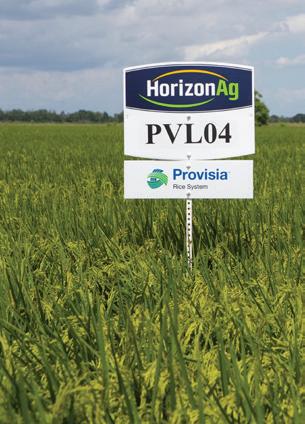
Plant Early – Both PVL03 and PVL04 should be planted early in the planting window to maximize yield potential and mitigate disease risk.
Start Clean, Stay Clean – Provisia herbicide is very effective on grasses, and farmers say their Provisia rice fields are the cleanest on their farms. That said, Dr. Walker says it is a mistake to take a “Roundup Ready” mentality when it comes to Provisia rice.
“I once heard a weed scientist say that Provisia was such a good grass control material that it could kill a fence post, and a lot of farmers took that sentiment to heart early on with the system,” he says. “Instead, we need to use Provisia herbicide with the intent to control only weedy rice.”

Weed control best management practices include:
· Starting with a clean field.
· Overlapping residual herbicides.
· Not making the first application of Provisia until temperatures are 60 degrees or above for three consecutive days.
· Making three applications of Provisia herbicide at the 10-11 oz. application rate versus two at the higher labeled rate.
· Using spray volumes of at least 7 gallons per acre by air and 10-15 gallons per acre by ground.
Watch the Weather – Dr. Connor Webster, LSU AgCenter weed scientist, says it’s not unusual for rice to experience some initial flashing from a Provisia herbicide application during periods of cool, cloudy weather, and the crop can recover quickly. Higher rate applications during those weather conditions, however, can result in a more adverse crop response.

“Every call that I’ve ever been to regarding herbicide injury and weather conditions has been at the 13 oz. to 15 ½ oz. rate,” he told farmers during a recent best management practices webinar. “We’re not seeing any issues with those 10 oz. applications. When you’re experiencing a period of cloudy weather or low temperatures, think about backing down and using the three 10 oz. application program.”
Plant Health – Maintaining healthy plants minimizes the risk of adverse environmental impacts and potential herbicide antagonism. Critical practices include using a recommended seed treatment, making timely fertilizer applications and monitoring for disease to keep plants healthy from the start and throughout key times in the season.
Detailed stewardship recommendations and best management practices are available at horizonseed.com/varieties. Information also is available on the Horizon Ag Productivity App available in the App Store or Google Play.


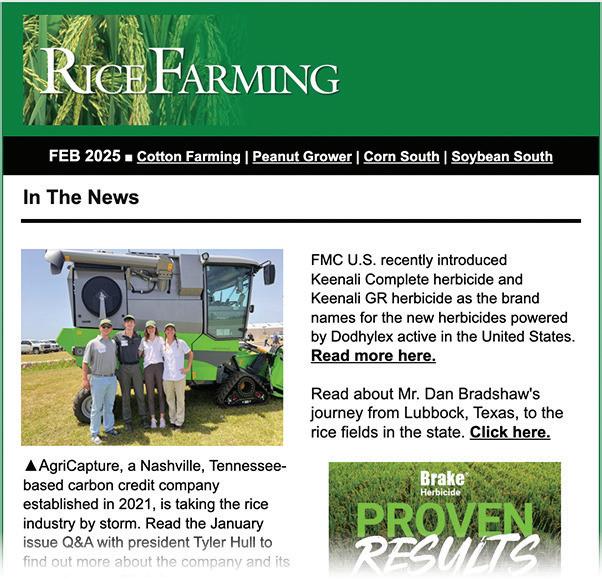
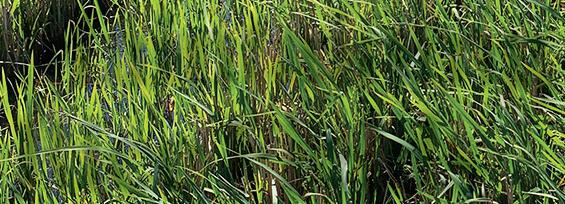

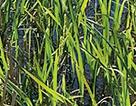
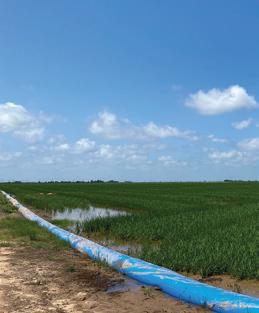





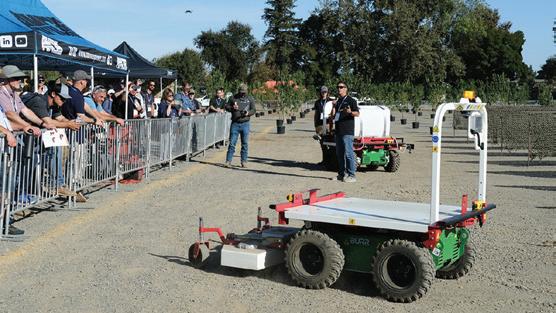






It’s that time of year again! Planting is just beginning, if not already well underway, and the speed of the year seems to be picking up. In keeping with the busy time of year, this month’s issue has a little bit of everything.
Peter Bachmann, cEO of USa rice, details the impact of tariffs as they relate to the rice industry on page five: “Amidst all the Washington chaos about the short- and long-term impacts of import tariffs and retaliatory tariffs by many of our trading partners, there is still untapped potential for improved market access, economic growth, and a chance at leveling the playing field.”

Cassidy Nemec Editor
On page six, Brad Watkins, professor at the University of arkansas, breaks down the current state of crop share for rice in the Mid-South: “Crop share arrangements tend to change little over time, but increasing crop prices, rising input costs, or new technologies make it occasionally necessary to reevaluate the equitability of crop share arrangements for both parties.”
This month’s cover story features an interesting look at different ways to maintain rice fields to maximize food supply for crawfish in Louisiana: “Ratoon-specific practices include bushhogging the stubble; rolling the main-crop stubble following harvest with an implement that incorporates it into the soil; or spreading of the straw to prevent clumping; and the reduction of regrowth in the combine row.”
In ag law and policy news, Brooke rollins has officially been confirmed as the new Secretary of agriculture. read more about her on pages 10 and 11. In addition to this policy news, you can read about california revisiting the current state ban on driverless tractors beginning on page 14.
Don’t miss the Specialists Speaking section this month! Sam rustom, Texas rice specialist, gives his perspective as a former weed scientist on weeds in rice: “Early season weeds tend to be more competitive with crops, especially rice, meaning this is the most important time to be aggressive with herbicides. As a matter of fact, this rice weed scientist turned specialist will tell you there’s never a time to not be aggressive with herbicides prior to flooding.”
I really enjoyed this month’s My Turn and know you will, too! Jim Whitaker, McGehee, arkansas, native, wrote about his life growing up farming, the importance of leadership and the checkoff, those that work on our behalf every day in the industry, and even his secrets to success.
There will be no shortage of information this month, so I hope you all get a chance to read amongst the craziness of this time of year. I’m praying for a smooth planting season and am already looking forward to hearing the stories the season will bring!
Editor Cassidy Nemec cnemec@onegrower.com
Copy Editor Carroll Smith csmith@onegrower.com
Digital Content Editor Katie Guthrie kguthrie@onegrower.com
Art Director Ashley Kumpe akumpe@onegrower.com
Publisher/Vice President Lia Guthrie 901-497-3689 lguthrie@onegrower.com
Associate Publisher/Editor-In-Chief Carroll Smith 901-326-4443 csmith@onegrower.com
Associate Publisher/Sales Manager Scott Emerson 386-462-1532 semerson@onegrower.com
Production Manager David Boyd dboyd@onegrower.com
Audience Services Kate Thomas 847-559-7514
For subscription changes or change of address, call 847-559-7578 or email ricefarming@omeda.com.
ONE GROWER PUBLISHING, LLC
Mike Lamensdorf President/Treasurer Lia Guthrie Publisher/Vice President
ASSOCIATED PUBLICATIONS — One Grower Publishing LLC also publishes COTTON FARMING, THE PEANUT GROWER, SOYBEAN SOUTH and CORN SOUTH magazines. RICE FARMING (ISSN 0194-0929) is published monthly January through May, and December, by One Grower Publishing LLC, 875 W. Poplar Ave., Suite 23, Box 305, Collierville, TN 38017. POSTMASTER: Send address changes to OMEDA COMMUNICATIONS, CUSTOMER SERVICE DEPARTMENT, P.O. BOX 1388, NORTHBROOK, IL 60065-1388. Annual subscriptions are $25.00. International rates are $55.00 Canada/Mexico, $90.00 all other countries for Air-Speeded Delivery. (Surface delivery not available due to problems in reliability.) $5.00 single copy.
All statements, including product claims, are those of the person or organization making the statement or claim. The publisher does not adopt any such statement or claims as its own and any such statement or claim does not necessarily reflect the opinion of the publisher. RICE FARMING is a registered trademark of One Grower Publishing LLC, which reserves all rights granted by the U.S. Patent and Trademark Office in association with its registration.
© Copyright 2025
Send comments to: Editor, Rice Farming Magazine, 875 W. Poplar ave., Suite 23, Box 305, collierville, TN 38017 or email cnemec@onegrower.com.
One Grower Publishing, LLC 875 W. Poplar Ave., Suite 23, Box 305 Collierville, TN 38017

By Peter Bachmann President and CEO USA Rice
When you think about the saying, “chaos is a ladder,” trade may not come to mind for most, but it does for me.
amidst all the Washington chaos about the short- and long-term impacts of import tariffs and retaliatory tariffs by many of our trading partners, there is still untapped potential for improved market access, economic growth, and a chance at leveling the playing field. rice is one of the most protected commodities in the world and I accept that its cultural and political sensitivity has caused drama in many trade negotiations over the years. It’s a staple food for more than half of the globe and growing, processing, shipping, and selling it provides food and jobs for billions of people on six continents. here in the U.S., rice farming and the associated businesses provide more than 125,000 jobs in small rural towns and contribute more than $34 billion to the U.S. economy every year.

We export half of that rice crop to more than 120 countries and we’re a vital part of U.S. domestic and international food aid programs. We supply the U.S. retail, wholesale, and food service sectors, but we’re also an important ingredient in american-made products from anheuser-Busch beer and breakfast cereal, to pet food, energy bars, and more. It’s safe to say U.S.-grown rice is consumed in some form or fashion in every
county across our country each day.
We are leaps and bounds ahead of our global competitors in sustainability efforts, food safety, and worker protections; and we know you are working on razor thin, and sometimes negative, margins.
Our industry has always been a champion for free trade agreements, and we have seen economic benefits from nearly all the U.S. agreements that incorporated increased access for rice at some point. But free trade is not necessarily fair trade.
The Office of the U.S. Trade representative found that India subsidizes their rice farmers in excess of 90 percent of their value of production. India’s government covers costs from seed to fertilizer to irrigation. They then buy the rice at a generous guaranteed rate and sell it back to private rice mills for cents on the dollar, where eventually that rice makes its way into the world trade channels at a discounted price. It is impossible for our farmers and processors to compete, and while we win cases at the World Trade Organization, enforcement is anemic.
Other global competitors: Thailand, Pakistan, china, and Vietnam, are encroaching not only on our third country markets, but also right here in our backyard.
Imports of foreign rice into the U.S. have doubled in the last decade with imports from India and Thailand alone equaling $1.2 billion.
President Trump has repeatedly said ‘tariff’ is the most beautiful word in the dictionary. It’s time for him to come to the defense of our farmers through targeted, product-specific reciprocal tariffs against bad actors.
I understand tariffs can be a double-edged sword. They can’t protect a domestic industry that does not exist. But we do have a domestic rice industry. One that is being treated very badly by trade cheats who take us for suckers. If any administration is going to stand up for american rice farmers, I believe it will be this one.
I encourage incoming USTr ambassador Greer, and the rest of the administration, to strategically review all agricultural products and trading partners to avoid unintended consequences, but at the end of the day, it’s tariff time.
By Brad Watkins
High input prices in recent years have significantly reduced profit margins for rice producers in the Mid-South. The negative impact of tightening profit margins is felt most acutely by rice producers renting cropland. a significant portion of rice ground in the region is rented using crop share arrangements, and the most common lease used is a net crop share lease. The terms of crop share leases differ by crop and region.
Typically for rice in the Mid-South, the landlord supplies the land and pays all below-ground irrigation expenses (well, pump, gearhead fixed expenses) in exchange for a share of the crop. The tenant pays all above-ground irrigation expenses (irrigation power unit fixed expenses, irrigation energy), supplies all machinery, and pays virtually all variable costs. The rice drying cost is the only variable cost shared between the two parties. Other crop share leases exist where specific costs like fertilizer are shared, but these lease types are less common than the net crop share lease.
Net crop shares are very similar throughout the Mid-South. In Eastern arkansas, the landlord’s share of the rice crop is typically 25%, but 20% crop shares are also common. In Northeastern Louisiana, the landlord’s share of the rice crop is typically 20%. crop share leases are used less frequently in Northwestern Mississippi relative to cash leases, but when a crop share lease is used, the landlord’s share of the rice crop is also typically 20%.
crop share arrangements tend to change little over time, but increasing crop prices, rising input costs, or new technologies make it occasionally necessary to reevaluate the equitability of crop share arrangements for both parties.
This article demonstrates the contributions approach as a method to calculate equitable crop and cost shares for rice rental leases. The first step is to calculate the percentage contribution provided by each party in value of non-shared expenses. remaining shared
inputs and income are then shared in the same percentages as the collective non-shared contributions made by both parties.
Table 1 demonstrates how the contributions approach reflects the typical net crop share lease used in the Mid-South. In this example, the only cost item shared is drying costs. all other cost items are contributed solely by the landlord or the tenant. Total non-shared contributions equal $1,311, of which the landlord provides $250 (19.1%) and the tenant provides $1,061 (80.9%). The assumption then would be that drying costs and crop income would appropriately be shared at the same 19.1 / 80.9 percentages, which approaches the 20% landlord, 80% tenant split seen in many net crop share leases in the Mid-South.
Table 2 shows how the contributions approach may be applied to a crop share arrangement where several cost items are shared between the landlord and the tenant. In this table, the two parties share fertilizer, herbicide, and drying costs. The sharing of fertilizer and herbicide costs between the two parties is in accordance with the concept that yield-increasing inputs should be shared in the same percentage as the crop is shared. an argument can be made that irrigation energy costs also fall into this yield-increasing input category. however, the cost of items to be shared or not shared in a crop share lease are based on negotiation between the tenant and the landlord.
Note in this example that the landlord’s share of the crop becomes larger when more cost items are shared between the two parties. This result occurs because the total proportion of contributions made by the landlord (particularly the land contribution but also irrigation wells) becomes larger when more costs are shared between the two parties. The equitable crop shares for each party, based on Table 2, are 24.5% of the gross returns for the landlord and 75.5% of the gross returns for the tenant.
See this full article with references at southernagtoday.org.
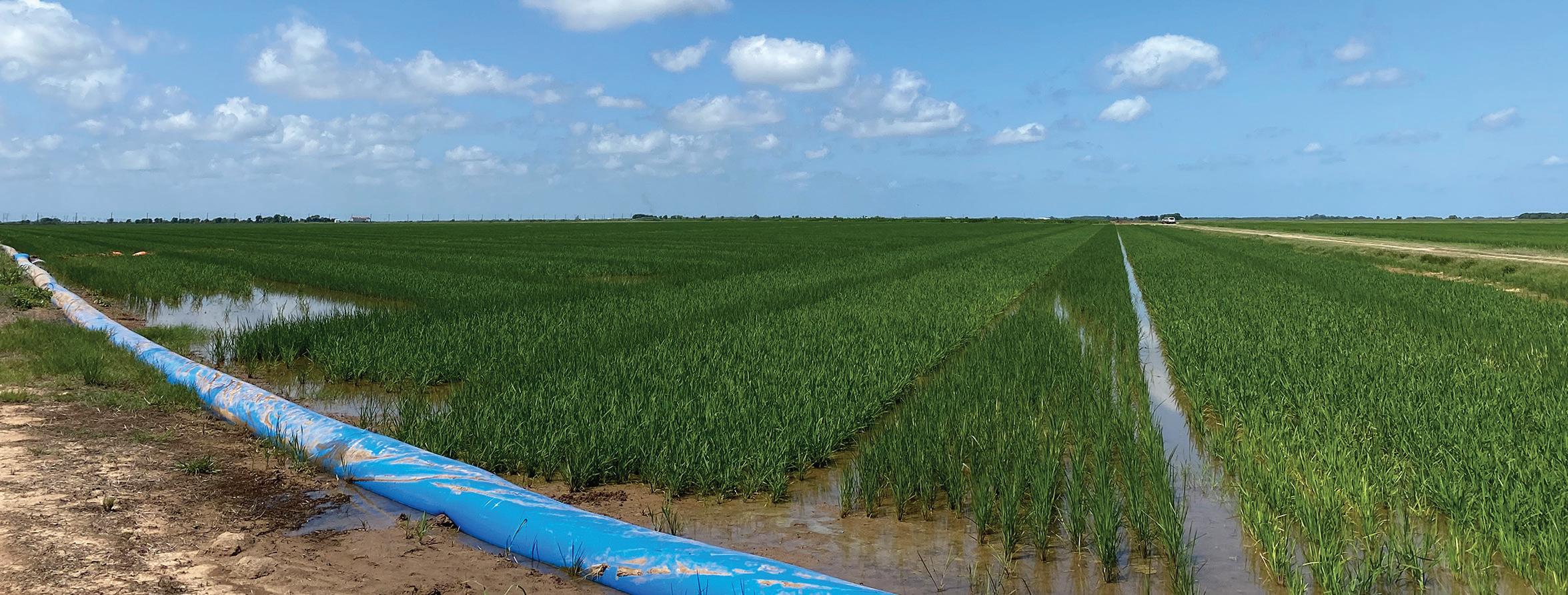
Table 1. Rice Net Crop Share Lease (Only Drying Expenses Shared)
a Annual cost items except Land and Management are rice production costs averaged across 2024 University of Arkansas rice crop enterprise budgets.
b The land charge is calculated as the average value for irrigated cropland in Eastern Arkansas reported in ASFMRA (2024) ($5,963/acre) multiplied by the rent-to-value ratio for irrigated cropland obtained from USDA NASS Arkansas (2024) ($152/acre cash rent divided by $4,200/acre for irrigated cropland).
c The management charge is calculated as rice gross return multiplied by the mid-range of charges for professional farm managers (5 to 10%).
a Annual cost items except Land and Management are rice production costs averaged across 2024 University of Arkansas rice crop enterprise budgets.
b The land charge is calculated as the average value for irrigated cropland in Eastern Arkansas ($5,963/acre) multiplied by the rent-to-value ratio for irrigated cropland obtained from USDA NASS Arkansas (2024) ($152/acre cash rent divided by $4,200/acre for irrigated cropland).
c The management charge is calculated as rice gross return multiplied by the mid-range of charges for professional farm managers (5 to 10%).
By Deborah Willenborg
It was a packed house at the Bolivar county Extension auditorium for the Mississippi rice council annual meeting recently. President Kirk Satterfield welcomed and thanked attendees and provided both his President’s report and the Mississippi rice Promotion Board’s report for chairman Patrick Swindoll who was unable to attend.
Doctoral candidate anna Smyly gave an update on the research being undertaken at the Delta research & Extension center, including a three-year irrigation and fertility study, and an in-depth analysis of tailwater recovery systems.
Bolivar county Extension coordinator Laura Jane Giaccaglia provided a detailed account of 2024’s promotion activities, starting with representation and merchandise sales at the cotton & rice conference, Gin Show, and other events. She talked about the emphasis on nutrition messaging that is resonating well with consumers and featured in their cookbook, “Between the Levees.” She highlighted the activities at, and growth of, the 4th annual Delta rice Festival and discussed plans that are underway to mark the 35th National rice Month later this year. She then introduced the reigning Delta rice Queen, Sloane Walker.
Ms. Walker shared her impressive stump speech about the importance and significance of rice to the Mississippi Delta, thanked the group for her $2,500 scholarship, and shared her plans to begin studying agriculture law at the University of Mississippi in the fall.
Parker Frew from Delta Wildlife/Delta F.a.r.M. was pinch hitting for the Ducks Unlimited team and provided an update on the climate Smart commodity program that is a joint project of USa rice, Ducks Unlimited, and the National Black Growers council.
Satterfield then turned the program over to staff from the Natural resource conservation Service to update the group on their programs. Gary Barbati and Patrick Pitt explained the ins and outs of the EQIP and cSP programs, including the application process.
“If you have any questions at all, visit your local field office — there’s one in every county here, and staff there can help walk you through the process with your application,” Barbati said.
Satterfield turned the attention to the national and global level, praised the work USa rice does on behalf of the industry, and introduced USa rice president & cEO Peter Bachmann. Bachmann thanked attendees for their continued support and spoke about the current uncertainty in Washington stemming from the first few weeks of the Trump administration. “I think of chaos as a ladder, and that presents opportunities for us,” Bachmann said. “Particularly when it comes to economic issues like trade.”
he covered the new promotion funding the industry received at the end of the Biden administration, as well as the temporary

funding freezes that are impacting the rice industry, tariffs and potential trade friction that could disrupt the industry further, and the lack of a Farm Bill — noting that, “when I was here last year, I said I thought we would get a new Farm Bill soon; well here we are, still no Farm Bill.”
Despite these challenges, Bachmann shared that he remains quite optimistic for the industry, noting that while he was speaking, the U.S. Senate confirmed Secretary of agriculture Brooke rollins who he is looking forward to working with.
Bachmann then introduced vice president of communications & strategic development Michael Klein to provide additional updates. Klein offered a quick glimpse into USa rice’s international promotion activities including trade servicing activities, social media programs, and retail promotions in key markets. he then shifted to talk about domestic promotions, including the robust foodservice program, social media influencer activities, retail partnerships, and the new “Grown in the USa” labeling program.
he closed sharing a major success story from the USa rice Domestic Promotion and communications teams: bringing the Sara Moulton TV show to Mississippi.
“We always envisioned Sara filming in the USa rice council’s four states,” Klein said. “We did Louisiana with randy Thibodeaux in 2016, arkansas with Eric Vaught in 2017, california with Matthew Sligar in 2019, and then the pandemic shut everything down. But we always knew we wanted to get to Mississippi, and we finally did in 2024!”
Satterfield closed the meeting by thanking everyone in attendance and all presenters. There followed, as always, an outstanding meal of fried catfish, hushpuppies, coleslaw, Mississippi rice, and a peach dessert.
Deborah Willenborg is the director of marketing & communications at USA Rice and may be reached at dwillenborg@usarice.com.

By Michael Klein USA Rice
More than 300 rice researchers from around the world gathered in New Orleans recently for the 40th biennial rice Technical Working Group meeting to discuss everything from agronomy, breeding, and cytogenics to utilization, weed control, and yield.
Over four days, attendees had their work cut out for them navigating daily schedules, with the event offering more than 151 oral presentations in six discipline panels, multiple committee meetings, three symposia, education sessions, a general session, an industry lunch, an awards lunch, and poster sessions highlighting 102 fledgling research projects.
Following a quick rTWG business meeting, chair Jarrod hardke from the University of arkansas, and secretary adam Famoso from the Louisiana State University agcenter, welcomed attendees, thanked the organizers and volunteers who made the massive event hum, including USa rice’s Jeanette Davis, and kicked off the General Session.
after brief remarks from Michael Salassi, director of the Louisiana agricultural Experiment Station, Dr. robert Zeigler, former director of the International rice research Institute and current Global rice research Foundation director spoke at length about the importance of rice to the world and subsequently rice research.
“In asia there’s a saying, ‘rice is life,’” Zeigler said. “rice feeds 50% of people around the world and 75% of the world’s poor. The fate of the world depends on rice.”
Louisiana rice farmer and former chair of the Louisiana rice research Board Jackie Loewer shared an often humorous take on how farming has changed in the decades he’s been raising rice in
southwest Louisiana, but he got serious when discussing the value of research.
“We farmers fund some of your research, but we are end users of all of it,” he said. “We couldn’t do what we do if you didn’t do what you do.”
at the industry lunch later, keynote speaker Bobby hanks, cEO of Supreme rice Mill, updated attendees on how his company is working to support local rice farmers with programs like climate Smart commodity grants and harvest support. he expressed appreciation for the hard work of the rice research community but added the U.S. government has a role to play as well.
“Twenty years ago, long grain imports were less than 9% of U.S. consumption. Next year, it could be more than 31%,” he said. “We need aromatic varieties that work for farmers and a government trade policy that protects U.S. farmers from the undisputed cheating of countries like India.”
Breakout sessions dove deep into everything from breeding breakthroughs to microwave drying technologies, and crop protectants and nutrients to how planting decisions impact profitability.
In pursuit of nurturing younger researchers, one of the symposia featured more than a dozen veteran scientists talking about how they’ve navigated personal and professional challenges throughout their careers. It was particularly relevant in the current atmosphere of uncertainty around federal grant spending, including on research.
rTWG maintains an excellent website where past papers are indexed, and proceedings of this event will be housed soon. The 41st rTWG will take place in February 2027 in Galveston, Texas.
By Katherine Hancock
Texas a&M college of agriculture and Life Sciences former student Brooke rollins ’94 has been confirmed as the U.S. Secretary of agriculture. She is the first Texan and the first Texas a&M University former student to hold the position.
Texas a&M college of agriculture and Life Sciences former student Brooke rollins ’94 was sworn in as the U.S. Secretary of agriculture.
Going first is not new to rollins. She was Texas a&M University’s first female student body president after being “called to something bigger than herself,” setting the tone for a career rooted in public service, according to an article shared by the Texas a&M Foundation’s Maroon Magazine.
During her conversation with Maroon Magazine, she described her inspiration for public service.
“I’m excited to see the next steps she takes for American agriculture.”
JOHN SHARP, chancellor of the Texas A&M University System
“While walking through the Memorial Student center at the beginning of my freshman year, I read the names of aggies who had given the ultimate sacrifice for our country. I realized the important role this university played in the never-ending battle for freedom. a few months later, I sat on the concrete steps of the G. rollie White coliseum after experiencing my first campus Muster ceremony. at that moment, I knew that servant leadership and Texas a&M would forever be an integral part of who I am. Students before me had already laid the pathway of service, and I wanted to spend the rest of my life living up to the standard of being an aggie,” rollins said.
The Glen rose native graduated with a bachelor’s degree in agricultural development from the Department of agricultural Leadership, Education, and communications.
“It is always great to see Texas a&M represented in government, but we’re especially excited to see aggies in the President’s cabinet,” said John Sharp, chancellor of the Texas a&M University System. “aggies bring big ideas to fruition; we don’t limit ourselves on ideas, and I’m excited to see the next steps she takes for american agriculture.”
The Senate committee on agriculture, Nutrition, and Forestry voted unanimously to advance her nomination after her hearing in February.
“Secretary rollins is a shining example of the outstanding leaders we develop here at Texas a&M,” said General (ret.) Mark a Welsh III, president of Texas a&M University. “She has a long

list of accomplishments both in and out of the agricultural field and has carried the aggie core Values with her throughout her outstanding career. and now, she will share that commitment to excellence and selfless service with the american people. aggies everywhere are beaming with pride for her today. Lead ’em well, Madam Secretary … and Gig ’em!”
rollins grew up on her family’s farm, where she developed a strong foundation in agriculture through hands-on experience. She was actively involved in Texas 4-h and the National FFa Organization, where she served as a state FFa officer for Texas. her background in agricultural education and leadership shaped her career, and she makes history as the first state FFa officer to serve as the U.S. Secretary of agriculture.
after graduating from Texas a&M, rollins earned a law degree from the University of Texas. She served as Gov. rick Perry’s policy director, then led the Texas Public Policy Foundation, a politi-
cal policy think tank.
“We like to say in the College of Agriculture and Life Sciences that we’re home to the ‘best and brightest,’ and Brooke is certainly that,” said Je rey W. Savell, Ph.D., vice chancellor and dean of Agriculture and Life Sciences.
“Her steadfast dedication to agriculture and Texas A&M is obvious, and we are so proud to see another former student pave the way for agriculture. We believe agriculture is the solution at Texas A&M.”
In 2018, Rollins was recruited to run the White House’s O ce of American Innovation and, ultimately, the Domestic Policy Council. She then founded the America First Policy Institute, a nonpro t, nonpartisan research institute. She and her husband, Mark Rollins ’94, most recently lived in Fort Worth with their four children.
Katherine Hancock is the assistant vice chancellor for marketing and communications at Texas A&M AgriLife and may be reached at katherine.hancock@ ag.tamu.edu.
By Jamison Cruce
USA Rice is thrilled with the timely con rmation of Brooke Rollins as U.S. Secretary of Agriculture.
e U.S. Senate approved Rollins with a 72-28 vote to lead the U.S. Department of Agriculture.
Rollins, who headed the Domestic Policy Council during Trump’s rst term in the White House, most recently served as president and CEO of the America First Policy Institute.
In her role as Secretary of Agriculture, Rollins will oversee the work of the entire Department, including farm, conservation, trade, and other programs important to rice farmers, millers, and merchants.
“We are grateful to Senator John Boozman, chairman of the Senate Agriculture, Nutrition, and Forestry Committee, for expediting Rollins’ con rmation,” said USA Rice President & CEO Peter

Bachmann. “We look forward to working with her to strengthen U.S. agriculture and ensure a prosperous future for rice.”
Provided by USA Rice’s e Daily.

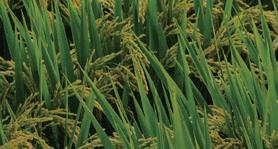




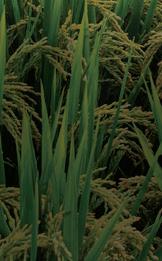


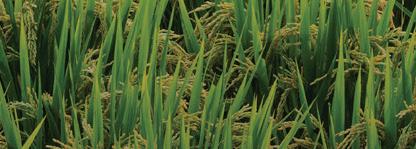




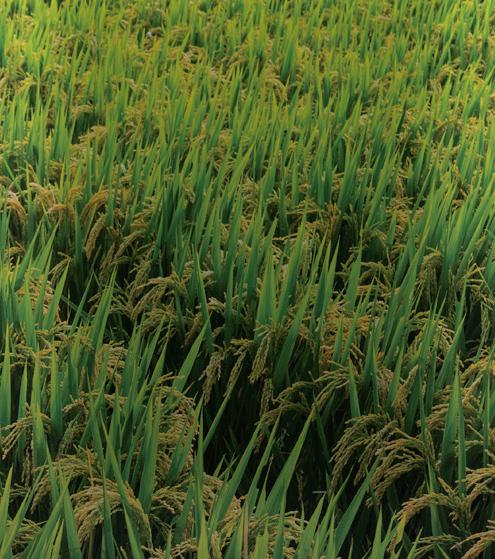
With a unique Group 12 mode of action, Brake® provides exceptional residual control in furrow-irrigated rice, targeting tough weeds like hemp sesbania, crabgrass, and Palmer amaranth.




By Mahala “Haley” Gambill and Mark Shirley LSU AgCenter
Crawfish aquaculture is the most profitable aquaculture endeavor in Louisiana, representing roughly 69% of the total gross farm value generated across all commercial aquaculture enterprises in 2022, according to the Louisiana Summary agriculture and Natural resources 2022. crawfish producers in South Louisiana create a suitable wetland habitat for crawfish to survive, reproduce, and grow to harvest size in shallow water impoundments used for both crawfish and rice.
The red swamp crawfish (Procambarus clarkii) and the white river crawfish (Procambarus zonan gulus) are the species of greatest commercial importance in Louisiana. crawfish receive their nutrition from sources within the pond, based largely on a detrital food chain. Put simply, a forage crop serves as the fuel for a food web, with crawfish at the top of the food web. Therefore, establishment of a forage crop that adequately provides material to the detrital pool throughout the season is an important aspect of food resource management.
In fields where a crawfish crop follows a rice crop, it is the stubble, harvest debris (straw), and ratoon rice growth (the production of a second rice crop in one cropping season) that create the food web for the duration of the crawfish season. rice is typically planted in March or april for harvest in July or august.
Ponds are drained during summer to establish a forage crop that serves as the foundation of the detritus-based food web when the pond is reflooded before crawfish harvest begins. Management of the ratoon rice crop differs from that of the first rice crop because chemical inputs, such as herbicides, insecticides, and fungicides, are seldom used. ratoon-specific practices include bushhogging the stubble; rolling the main-crop stubble following harvest with an implement that incorporates it into the soil; or spreading of the straw to prevent clumping; and the reduction of regrowth in the combine row.
additionally, delayed plant deterioration and ratoon regrowth may minimize dissolved oxygen demand in a crawfish pond during the fall because much of the biomass is in the form of green, living plant material, rather than decomposing straw and stubble. This also leads to staggered forage availability, with the forage components entering the detrital pool at different times during the production season. Previous ratoon stubble research has focused primarily on grain yield, yet few studies have assessed methods of ratoon crop management for the food supply of red swamp crawfish produced in rice ponds.
Four different stubble management schemes were evaluated at the LSU agcenter h rouse caffey rice research Station in crowley during the 2021-2022 crawfish season to identify the ef-

fects of ratoon crop manipulation methods on forage supply for crawfish. The treatments included bushhogging the stubble, rolling the stubble, and burning the straw off the top of the stubble. a control treatment involved scattering the straw and not manipulating the stubble in any way.
In addition, this research aimed to identify the effect of fertilization on crawfish food supply. Fertilizer was added to one set of treatments and not to the other set. Typically, 90 pounds of nitrogen per acre is recommended for ratoon rice production regardless of if stubble management is used or not. Total biomass was measured in each treatment monthly from October to May.
Biomass evaluations were made on vegetative (leaves and stem) dry weight. Dry weight determinations were made after drying tissue in a forced-air oven at 70 degrees celsius for 48 to 72 hours. an effects parameterization analysis of variance (aNOVa) and a






Four different stubble management schemes were evaluated at the LSU AgCenter H. Rouse Caffey Rice Research Station in Crowley during the 2021-2022 crawfish season to identify the effects of ratoon crop manipulation methods on forage supply for crawfish. The treatments included bushhogging the stubble, rolling the stubble, and burning the straw off the top of the stubble. Additional research aimed to identify the effect of fertilization on crawfish food supply.
multiple comparison of means were performed to assess the effect of the four common postharvest management methods on crawfish food supply during the season. a two-sample T-test was used to assess the difference in biomass between fertilized and nonfertilized stubble.
Overall, there was no significant difference between the stubble treatments. The biomass weights from bushhogging and rolling do not indicate a significant statistical difference to denote that their use is more beneficial, especially when factoring in the extra required time and fuel costs associated with them. although not significant, the control group and use of rolling show more biomass throughout the season. rolling of the stubble showed a persistence of biomass lasting longer throughout the season.
The only significant difference in this study was due to the addition of fertilizer after the rice crop was harvested. Management of the forage crop for crawfish under a rotational strategy is principally related to ensuring proper regrowth from the ratoon crop and minimizing the negative effects on water quality from breakdown of straw and debris from the grain harvest. Other studies note that rice stubble responds best to applications of fertilizer, followed by irrigation, shortly after grain harvest, as extended delays in supplying moisture to the stubble during dry conditions can result in poor regrowth.
The results of this study suggest that producers should evaluate the high operational costs, including those of time and resources, in methods of bushhogging and rolling of stubble to and consider instead the benefits of the application of fertilizer to rice stubble for season-long food supply for crawfish production.
By Caleb Hampton California Farm Bureau
New technologies have transformed the world during the past half-century. agriculture has been no exception, with the emergence of aerial drones, autonomous tractors, and other equipment changing the way crops are planted, cared for, and harvested.
One thing that hasn’t changed since 1977, however, is a regulation from california’s Division of Occupational Safety and health, or cal/OSha, that prohibits the use of autonomous agricultural equipment without a driver at the helm.
The regulation requires that all “self-propelled equipment shall, when under its own power and in motion, have an operator stationed at the vehicular controls.”
conceived long before the first driverless vehicle existed, the regulation has nevertheless prevented farmers from taking advantage of many types of autonomous equipment developed in recent years.
“It has the effect of preventing the use of any kind of autonomous vehicle in any agricultural location where people are employed,” said Bryan Little, chief operating officer of Farm Employers Labor Service and senior director of policy advocacy at the california Farm Bureau.
Driverless Tractor Use and Advantage
around the world, farms have benefited from driverless blast sprayers that apply pesticides to orchards and vineyards, autonomous weeders that use visualization technology and lasers to burn weeds, and assistive machines such as driverless carts — or mules — that work alongside people, ferrying bins of produce from the end of a row to a collection point to save workers time and labor.
In california, “Everyone in the industry is trying to determine the best way to operate within the confines of that regulation,” said Sean Sundberg, business integration manager at John Deere.
after years of advocacy from farm groups such as california Farm Bureau and california association of Winegrape Growers, change may be on the horizon.
In august, cal/OSha issued a memorandum clarifying that driverless tractors and other agricultural vehicles may be used without field workers present. When employees are absent, the location doesn’t qualify as a worksite under the agency’s jurisdiction.
The directive gave a clear greenlight for farmers in california to use equipment such as an autonomous blast sprayer manufactured by the Fresno county-based company GUSS, which applies pesticides in orchards and vineyards, doing so without workers on site for chemical safety reasons.
“Essentially, one person is sitting in a pickup truck on the side of the field with a laptop computer monitoring a fleet of up to eight of these machines,” said Gary Thompson, chief operating officer at GUSS.
The august memo has given farmers some clarity, Little said.

however, for many types of farm work, he added, “you need to have people around, and that restricts the use of autonomous equipment.”
In November, the cal/OSha Standards Board announced it was empaneling an advisory committee that comprise stakeholders to examine the regulation, signaling that the board may consider revising it.
Proposed changes may face pushback from labor advocates, who in the past have raised concerns about the safety of autonomous equipment and cautioned that widespread adoption of it could lead to job losses for agricultural workers.
Farm groups have vouched for the technology’s safety and said autonomous technology in many cases may improve worker safety and create upskilling opportunities for employees.
When it comes to safety, “We should be comparing the autonomous technology to the real world and what we have right now,” not an unachievable ideal, said Little, who will serve on the advisory committee.
The autonomous sprayer made by GUSS, for example, eliminates a job that traditionally required someone to be present in orchards and vineyards when pesticides were being sprayed. The vehicles move at about 2 miles per hour, and they have redundant safety features, including LIDar that detects people and obstacles, safety bumpers that trigger the engine to shut off and brakes to lock, and a safety vest supervisors wear that signals the machine to pause when within 30 feet of the vest.
Operating a traditional blast sprayer is “very tedious, boring work, most of the time done at night, going very slowly with chemicals spraying all around you,” Thompson said. “This was a job that was ripe for automation.”
Should cal/OSha end its ban on driverless tractors, farmers may see new types of equipment become available in the state.

With our team’s collective 200+ years tied to agricultural production, we believe in what we do.
We make it our mission to provide profitable production strategies to our farmers with information to improve their bottom lines.



Our seasoned editors cover every stage of production — from land preparation, to seed selection, to crop protection through harvest.


Contact Associate Publisher/Sales Scott Emerson at 386-462-1532 or semerson@onegrower.com to









Financial hardship hits agricultural producers in the Mid-South in a variety of ways — through increased costs, decreased commodity prices, natural disasters, and more — and an upcoming conference session aims to shed light on what producers can do in the face of heavy debt and possible bankruptcy.
at the 12th annual Mid-South agricultural and Environmental Law conference, the session “Dealing with Debt: Practical considerations in Preparing for and Navigating ag Bankruptcy” will be presented by russell Morgan, certified agricultural consultant, agribusiness advisor, and owner of Morgan agricultural consulting Services, and renee Williams, chapter 12 trustee at the U.S. Bankruptcy court for the Eastern and Western Districts of arkansas. Morgan and Williams have years of professional experience in navigating financial matters.
The conference will be held June 5-6 in Memphis, Tennessee, at the University of Memphis cecil c. humphreys School of Law and co-hosted by the National agricultural Law center and the National association of State Departments of agriculture Foundation, or NaSDa Foundation. a livestream option is also available.
registration for the Mid-South is available online at nationalaglawcenter.org/midsouth2025.
“agricultural producers face an array of production and financial challenges in their daily business operations — many of them unique to agriculture,” said Morgan. “a number of these challenges are outside their direct control, potentially impacting overall financial and debt situation to a very significant degree. Declining commodity prices, rising input costs, abnormal weather patterns, natural disasters, and various other factors can lead to substantially increased debt and/or reduced debt repayment capacity. chapter 12 bankruptcy may be an option for these producers to ‘Pause, Pivot, and Proceed.’”
With chapter 12, a debtor submits a repayment plan to a court for approval. The plan details how payments will be made to creditors, or those whom the debtor owes, on a consistent basis. creditors are involved in the court proceedings.
Williams noted that filing for chapter 12 bankruptcy is not something that should be taken lightly.
“agricultural bankruptcies have lingering impacts on producers and families,” she said. “There’s a lot to navigate when considering this process and if it’s a feasible option for your farm and family. I’m looking forward to discussing this important topic with russell at the Mid-South.”
NaLc Director harrison Pittman said many farmers are suffering financial difficulties.
“Many parts of the farm economy have been hit pretty darn hard year-over-year, and current market projections are often less than ideal,” said NaLc Director harrison Pittman. “This is creating a lot of issues for producers, landowners, lenders, and attorneys that represent these folks. We’re honored that renee and russell will share their deep experience with this year’s in-person and online attendees.”
For information about the NaLc, visit nationalaglawcenter.org. The NaLc is also on X, Facebook, and LinkedIn. Subscribe online to receive NaLc communications, including webinar

MidSouthConference — Attendees listen to a session at the annual Mid-South conference. This year’s program will feature a session on navigating farm debt and bankruptcy.
announcements, the NaLc’s Quarterly Newsletter, and The Feed.
Continuing
The Mid-South conference will be submitted for cLE accreditation in arkansas, Kansas, Mississippi, Missouri, and Tennessee. approval for cE will also be sought from the american Society of Farm Managers and rural appraisers. Those who register by May 13 are eligible for bonus cLE/cE through the online conference “Early Bird” on May 14.
— Drew Viguet, National Agricultural Law Center
h.L. Goodwin, arkansas professor emeritus, was honored recently by the Southern agricultural Economics association with its lifetime achievement award.
Goodwin was nominated for the award by Deacue Fields, a fellow agricultural economist, who is also head of the University of arkansas System Division of agriculture.
“Early in my career, Dr. Goodwin was viewed as one of the icons in SaEa,” Fields said. “he was always present and very active in SaEa events. he was always welcoming and extremely approachable. he had outstanding technical knowledge; however, his mentorship and words of wisdom to early career professionals were extremely valuable.”
Fields praised Goodwin for his engagement in the three landgrant missions: teaching, research, and Extension.
“as part of the teaching mission, he taught more than 10 undergraduate and six different graduate courses throughout his career,” Fields said, adding that “student testimonials indicate that he was very engaging in the classroom and had a lasting impact.”
Goodwin was also productive in the research mission, which is confirmed by nearly 50 articles in professional journals.
“Goodwin’s scholarship in land-grant activities is balanced by his numerous contributions to outreach and Extension,” Fields said. “he was well known and respected for his expertise as a poultry economist.”
In addition to creating lasting relationships with key poultry
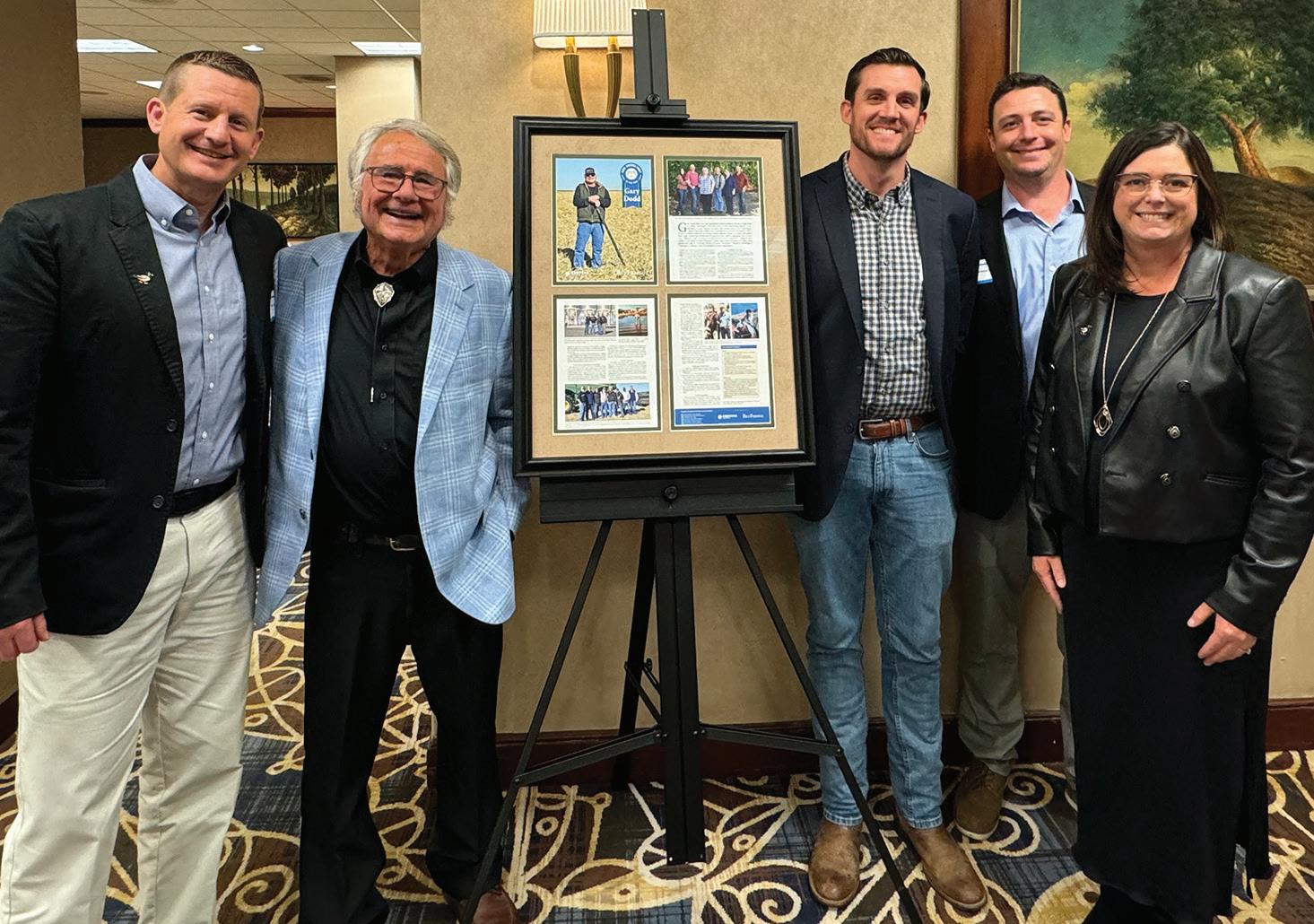

Rice Farming magazine and corteva were honored to present Mr. Gary Dodd (pictured second from left in left photo) of Yuba city, california, as the 2024 rice consultant of the Year.
Dodd is california’s first honoree and is the eighth rcOY.
Rice Farming and corteva are proud to present this prestigious award annually in Memphis, Tennessee, at the Mid-South Farm & Gin Show.
industry players such as Tyson Foods, Simmons Foods, and cobbVantress, “Goodwin has extended all areas of his work to the international community,” Fields said.
Lanier Nalley, head of arkansas’ agricultural economics and agribusiness department, for both the Division of agriculture and Dale Bumpers college of agricultural, Food, and Life Sciences, underscored Fields’ comments.
“h.L. Goodwin is a model of a land-grant faculty member,” he said. “his work on poultry Extension and research and in the classroom has made him one of the top poultry economists globally and one of the most respected teachers at the University of arkansas.
“The state of arkansas has been fortunate that h.L. has chosen to serve its stakeholders over his career. This award is well deserved and speaks to h.L.’s reputation as one of the country’s best ag economists,” Nalley said.
Goodwin served as SaEa president in 2007, served on the executive committee for several years and remained extremely active in the organization until his retirement. he was also co-director of the Southern risk Management Education center.
Goodwin joined the faculty at arkansas in 1996, and a year later joined the center of Excellence for Poultry Science as a poultry economist. he retired as a full professor in 2018.
Before 1997, Goodwin was agricultural and food systems adviser to Slovakia’s minister of agriculture and was a Fulbright Scholar in the former czechoslovakia from 1991-1992.
Prior to joining the arkansas faculty, Goodwin was associate director of the Texas agriculture Market research center from 1989-1995.
Goodwin earned his bachelor of science in agricultural educa-
additionally, the Killen family was presented with the honorary 2024 rice consultant of the Year award for William “Bill” Killen. Killen was an independent consultant based in cleveland, Mississippi, for many years.
Be on the lookout for nomination forms in upcoming issues of Rice Farming magazine to nominate a deserving individual for the 2025 rcOY.
tion from Oklahoma State University and stayed to earn a master’s and doctorate in agricultural economics.
— Mary Hightower, University of Arkansas System Division of Agriculture
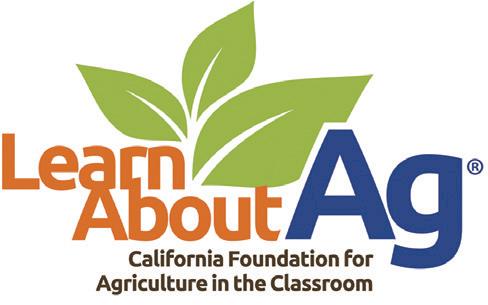
The california Foundation for agriculture in the classroom has a new executive director. amanda Fletcher assumed the position last month, succeeding Becca Whitman, the interim executive director. Fletcher previously worked as cFaITc’s administrative coordinator, with active roles in fundraising, donor relations, budget oversight, and event coordination. She was an auction manager at Bidcal Online auctions in Butte county, where she developed strategic planning, operational oversight, and management skills. She grew up in Dixon, where her family was involved in hay, row crops, and cattle.
“My agricultural roots run deep,” Fletcher said. “From my early involvement in 4-h and FFa to earning an agriculture education degree from california State University, chico, my lifelong commitment to agriculture has shaped my career.”
Whitman, who served six years on the cFaITc’s board of directors before guiding the organization through its transition, will continue to serve cFaITc with a focus on strategic partnerships and leadership development.
— Provided by California Farm Bureau

DR. JARROD T. HARDKE ARKANSAS
Professor/Rice Extension Agronomist University of Arkansas System Division of Agriculture jhardke@uada.edu
The best weed control recommendation out there continues to be “don’t let them come up.” Overlapping residuals is the consistent theme of weed control recommendations in rice, especially for grasses.
We certainly want to properly utilize burndown herbicides to begin with a clean slate, but from there, our residual herbicide chemistry needs to be the focus. When evaluating herbicide costs and various programs, those that lean on using our available herbicides that provide pre-emergence control make the budgets look the best.
command continues to be a foundational herbicide, but we need to look closely at how we incorporate Prowl, Bolero, and Facet for grass control as well. Prowl and Bolero have the wrinkle of being delayed pre-emergence products but are an excellent fit shortly after planting to mid-post to continue our weed control.
Facet has a wide window of use, and while some of it’s post-emergence, grass control may not be as effective anymore. however, it still has a significant role to play as a pre-emergence herbicide even on many of our barnyardgrass populations that are resistant to it as a post-emergence product.
Other products such as Sharpen, Gambit, and League can also serve us well as pre-emergence herbicides but vary depending on weeds we need to control.
clearfield and FullPage systems can utilize additional residual activity from Newpath or Preface. remember if you utilized those products last year, you cannot plant conventional rice or Provisia / Maxace rice this year, or carryover will give us issues.
Speaking of Provisia and Maxace, these products do not offer residual weed control. But note that we now recommend a Provisia program of 10 ounces early POST followed by 10 ounces midPOST, followed by 11 ounces post-flood. Our recommendations for Maxace remain the same with 15.5 ounces highcard early POST followed by 15.5 ounces highcard mid-POST and flood immediately. If you grew Provisia or Maxace last year, rotate to soybean this year to avoid outcrossing.
remember that planting into a stale seedbed environment helps to improve our overall rice stands but also minimizes weed emergence. Get the ground slick and leave it alone to limit weed emergence in the first place.
rice budgets, and other crop budgets, continue to get tighter.

Focusing on early season weed control and our residual herbicides will help us limit the more costly post-emergence herbicide applications later, which may be a key in skimming by this year. at a certain point, we just need to let weeds go, save the money, and live to farm another day.
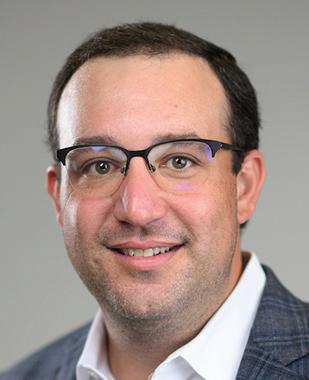
SAM RUSTOM TEXAS
Assistant Professor and Extension Agronomist
Texas A&M AgriLife Research and Extension
sam.rustom@ag.tamu.edu
Weed competition has been studied extensively throughout history and most of that research has suggested early season weed management is where it matters most regardless of crop. Early season weeds tend to be more competitive with crops, especially rice, meaning this is the most important time to be aggressive with herbicides. as a matter of fact, this rice weed scientist turned specialist will tell you there’s never a time to not be aggressive with herbicides prior to flooding.
When we talk early season weed management in rice, we’re typically talking about grasses like barnyardgrass, amazon sprangletop, and broadleaf signalgrass. Like all the other rice-growing states, barnyardgrass remains the No. 1 herbicide issue in Texas rice. Unfortunately, in 2024, we were able to confirm more barnyardgrass resistance to multiple modes of action across the Texas rice belt. It’s nothing new, especially with regards to propanil, but the issue is growing, and we are losing additional modes of action like Newpath, regiment, and Facet at a rapid pace. clearfield rice has long been the gold standard for weed control in rice, with the ability to use Newpath and Beyond in addition to all the other herbicides labeled in rice. historically, clearfield rice has been a three-shot system, with two applications of Newpath early and one application of Beyond later in the season.
In addition, Newpath has excellent residual activity. That being said, clearfield rice just isn’t cutting it in some areas of Texas these days. as a proud Louisiana State University alumnus, it hurts my heart to say that, but the system has been fantastic for 20 years and really has changed the way we grow rice, especially in Louisiana.
I am encouraging growers to utilize Provisia or Maxace varieties and apply quizalofop where their barnyardgrass issues are the worst or where the clearfield system is starting to slip. The quizalofop-resistant systems provide some of the best grass control I have ever seen in rice when used correctly.
Unlike the products used in clearfield rice, quizalofop only works on grasses, has no residual, and calls for a two-shot program instead of three. additionally, quizalofop is highly susceptible to herbicide antagonism. One of my favorite rice projects I have done thus far was my master’s, where we looked at most of
the tank-mix options available in Provisia rice, as well as timings of applications with antagonistic mix partners.
Because of the above-mentioned differences in clearfield and Provisia, growers should be ready to make some pretty significant changes to their herbicide programs and be ready to part with some products they have grown accustomed to using. In my master’s project, we learned that many of the products we love today might not be a good fit in quizalofop-resistant rice. The “big three” to avoid are regiment, Grasp (and Grasp Xtra), and propanil. For what it’s worth, you can throw 2,4-D in that mix as well. I think the pictures below tell the story much better than I can.
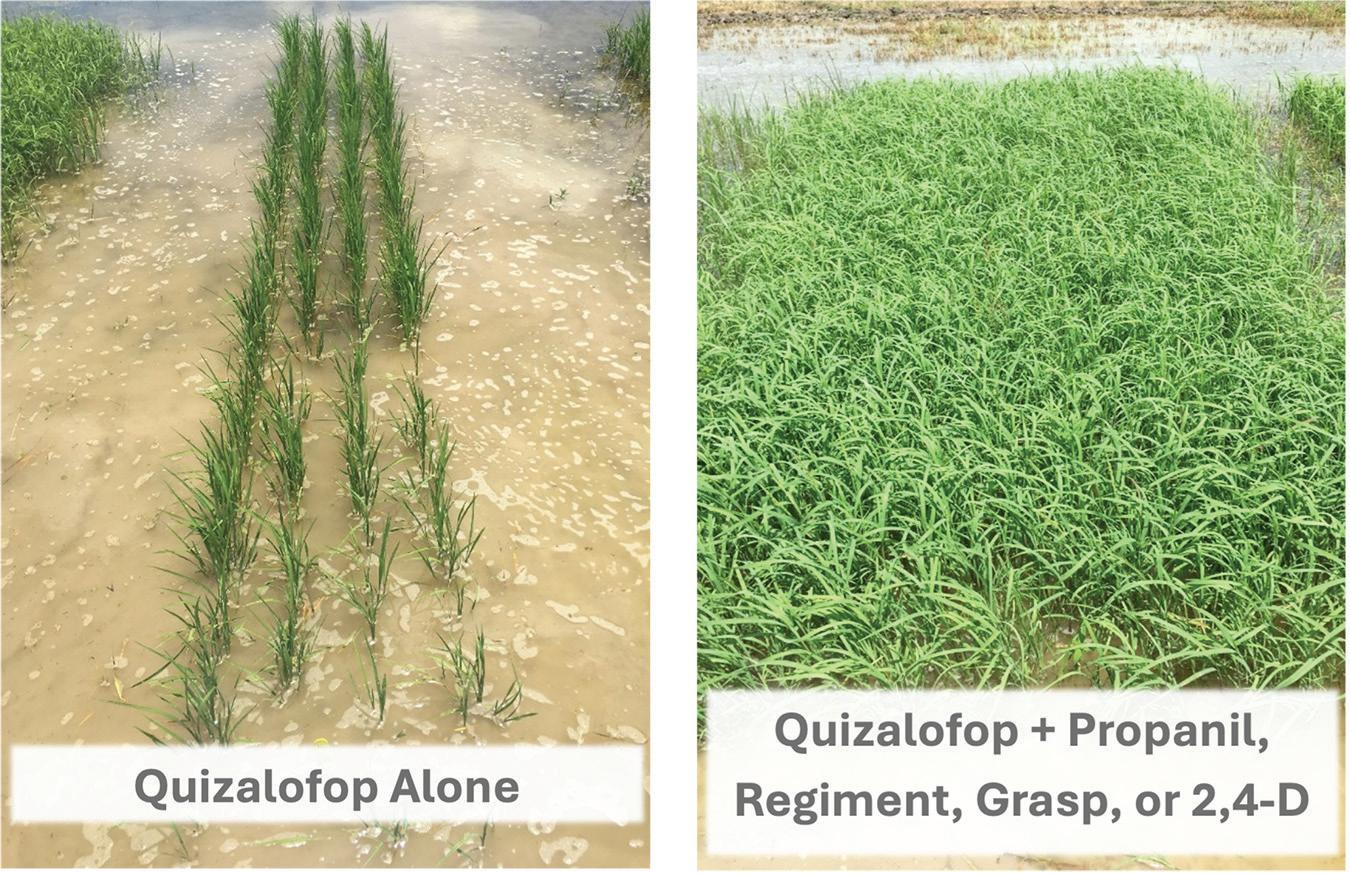
If utilizing Provisia rice, I would encourage growers to overlap residuals like Sharpen, Gambit, or League for broadleaf or sedge control; that way, we don’t have too many things going in the tank when quizalofop application time arrives. Most important, it is extremely beneficial to include one of these products in the pre-emergence application with command, potentially eliminating a broadleaf tank-mix partner from the first quizalofop application. Use Sharpen where pigweeds are present.
If a tank-mix is necessary in the first application, Permit at no more than an ounce has proven to be a solid mix partner with quizalofop. We also saw good results and little to no antagonism when we mixed it with Loyant, Basagran, aim. In addition, Bolero or Prowl are also good options for growers who are wisely wanting to overlay residuals with their first post-emergence quizalofop application. The second shot should always be applied alone, and both the first and second applications have looked great for me with a high-quality crop oil like concentrate like agri-Dex at 1% volume/volume.
If you are in a situation where an antagonistic mix partner needs to be used, our work suggested the quizalofop should go out first and at least 24 hours prior to the broadleaf product. I prefer several days before the broadleaf application just to be on the safe side, but any time up to 24 hours before should be fine.
In addition, growers should be aware that applying quizalofop in cloudy weather can lead to significant injury issues. For those who aren’t utilizing quizalofop-resistant technology, always remember overlapping residuals prior to flooding is a great enhancement or alternative to the postemergence products we are using, especially those post-emergence grass products that don’t work too well without a permanent flood on the field.
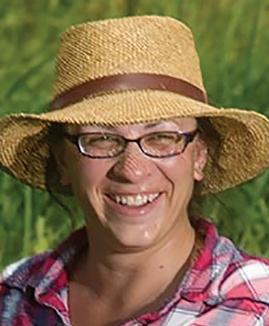
DR. WHITNEY BRIM-DEFOREST
CALIFORNIA Cooperative Extension Rice Advisor
University of California, Davis wbrimdeforest@ucanr.edu
California rice farmers are facing greater problems each year in controlling watergrass species. is is in part due to the spread of a new species (coast cockspur) but also due to the increasing number of elds with resistant biotypes of all watergrass species (barnyardgrass, late watergrass, and early watergrass). New products are coming down the pipeline, but in the meantime, the best way to combat these grasses is to have a plan going into the season, instead of trying to deal with grass control late in the season.

In the worst elds, a stale seedbed can be a good option. e purpose of a stale seedbed is to bring up weeds prior to rice planting, which can then enable the use of a non-selective herbicide such as glyphosate or capric/caprylic acid. A stale seedbed can also work in a year when it rains late or a er tillage. A ush of water, whether from rain or irrigation, and a week of warm weather can bring up a large number of watergrass plants.
Past research has shown that as much as 90% of a population can emerge in about 10 days (this varies somewhat according to temperature). Many growers do not like using a stale seedbed as it can delay planting, but it can be a good option for rotation on one eld at a time, to try to clean up a eld. Work with your local Farm
Advisor for the best timing and for guidance on application rates. If a stale seedbed is not a possibility, it is important to use multiple modes of action at the beginning of the season. Many watergrass biotypes have widespread resistance to granular herbicides, particularly those containing thiobencarb, benzobicyclon, and penoxsulam. Some elds may also have clomazone resistance, but it is less widespread. e best solution is to combine modes of action to attempt to overcome resistance. Resistance in watergrass species in California is metabolic, meaning that the plant can break down, or “metabolize” or “eat” the products, detoxifying them within the plant system, rendering the herbicides ine ective.
e positive part of having metabolic resistance is that unlike target-site resistance, it can be overcome, usually through increased rates and/or combinations of products either applied in close succession or at the same time. Some combinations that are popular and work fairly well for watergrass control are: pyraclonil and benzobicyclon, clomazone and benzobicyclon, and clomazone and thiobencarb (not an exhaustive list). ese tend to work best when applied at the highest labeled rates, and either at the same time (if the label allows), or in close succession.
Whitney Brim-DeForest says, “Many growers do not like using a stale seedbed as it can delay planting, but it can be a good option for rotation on one field at a time, to try to clean up a field.”

Be mindful of phytotoxicity, particularly on red soils on the east side of the Sacramento Valley, especially when applying the highest labeled rates. Not all these combinations will be e ective in all elds or checks, depending on the watergrass species and biotypes present. Trying one of these combinations on a small amount of acreage, or di erent combinations on di erent elds, can be helpful to determine what will work best on your acreage.
Although not helpful for the current year, sending in watergrass samples for resistance testing to the University of California Weed Science Program can be an e ective means to determine what products are working best on a particular eld or check. Please reach out to your local Farm Advisor for assistance in collection.

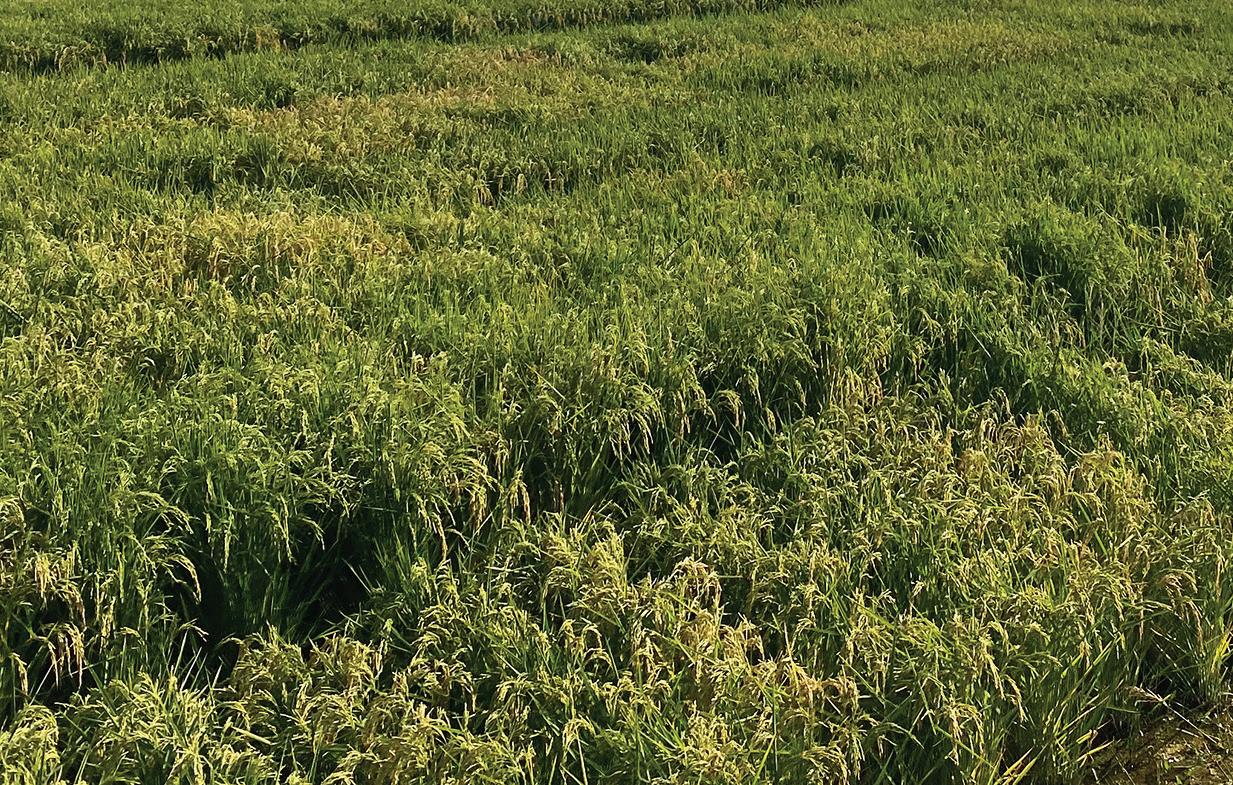

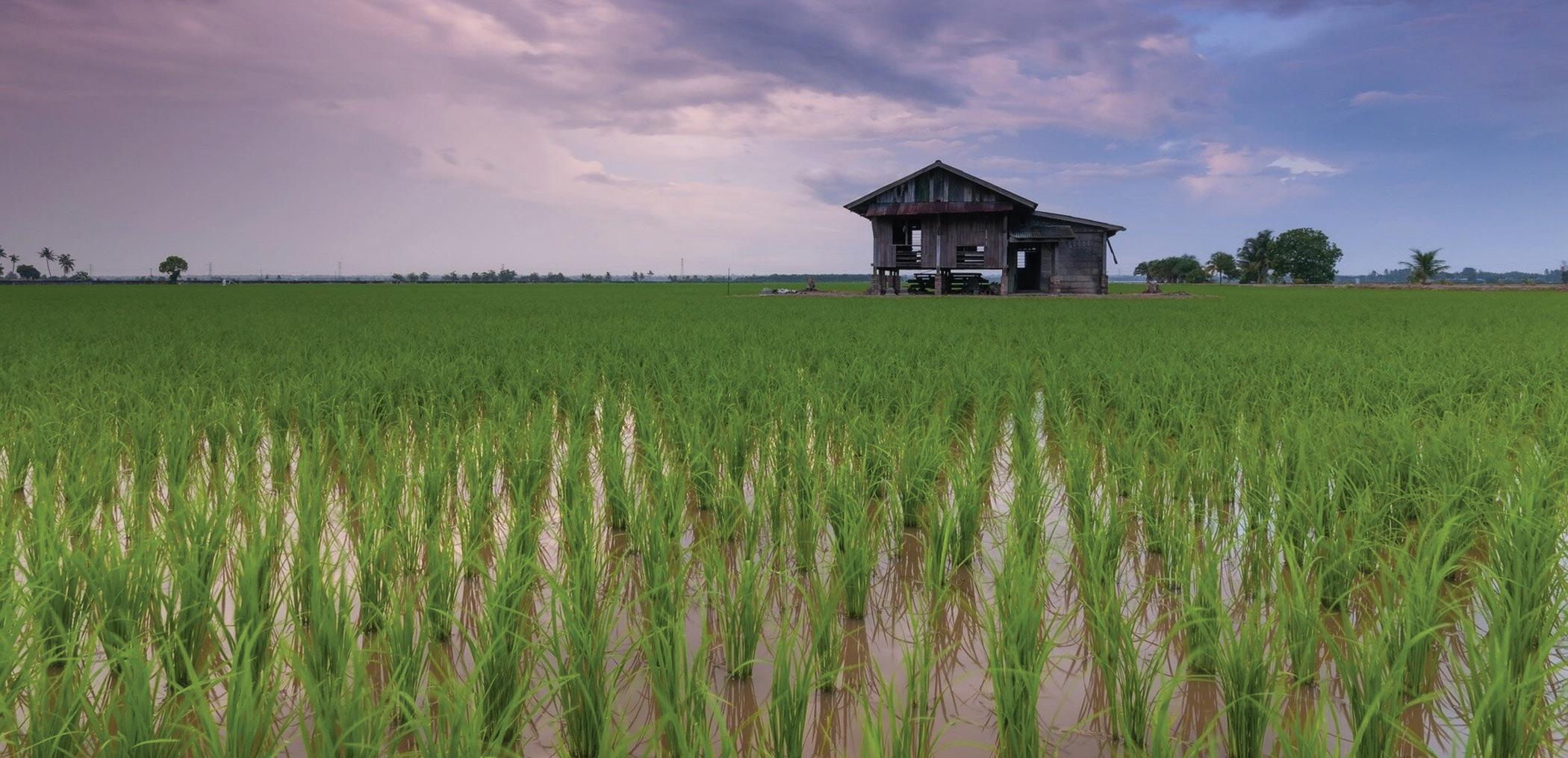
Agene called cOLD6 contributes to cold tolerance in rice, potentially offering a pathway to use molecular design to breed a rice variety with higher resistance to cold stress. This work appeared Oct. 30 in Molecular Cell
“cold damage is a major challenge in rice production, and identifying key gene modules in signaling pathways is a crucial step in addressing this issue,” said senior study author Kang chong of the chinese academy of Sciences.
“Our research focused on uncovering the molecular mechanism behind crops’ response to cold stress. We hope to improve cold tolerance through molecular design and ultimately stabilize yields even under cold damage.”
rice plays a crucial role in ensuring global food security worldwide. With more than 15 million hectares of rice cultivation areas already affected by chilling due to climate change, low temperature poses a significant challenge to rice cultivation in 24 countries.
as a result, a major goal in agriculture is to develop rice cultivars with enhanced tolerance to chilling through molecular design. While it is known that temperature sensors trigger ca2+ signaling to confer cold tolerance in cells, less is known about sensors that couple with other secondary messages.
“It has long been assumed that cold sensors couple with calcium ions to trigger temperature perception in cells,” chong said.
“Our study reveals a new pathway of temperature perception in cells. We found that a plasma membrane-localized cOLD6-OSM1 module triggered the production of the signaling molecule 2,’3’caMP, beyond calcium signaling, to initiate a defense reaction
to low temperature.”
In the new study, chong and colleagues identified a cold sensor complex consisting of chilling-tolerance divergence 6 (cOLD6) and osmotin-like protein (OSM1). Under normal conditions, cOLD6 interacts with rice G-protein α subunit (rGa1) at the plasma membrane.
Under chilling conditions, OSM1 physically binds to cOLD6, kicking out rGa1. This process, along with an increase in OSM1, leads to an elevation of 2,’3’-caMP levels, ultimately enhancing chilling tolerance in rice. These signaling mechanisms may also apply to other crops, improving their cold tolerance. however, more research is needed to determine the exact mechanism underlying the cOLD6-OSM1 module.
The researchers demonstrated that knockout and natural variation of cOLD6 in hybrid rice enhances chilling tolerance. The findings suggest that allelic variation in cOLD6 plays a role in geographical adaptation to growth temperature.
according to the authors, the results are consistent with molecular evidence of rice domestication, indicating that a substantial number of domesticated alleles originated from wild rice in South and Southeast asia.
“Overall, our findings suggest new strategies for breeding cold-resistant rice varieties,” chong said.
“By understanding how the cOLD6-OSM1 complex works, breeders can potentially develop rice to stabilize yields even under cold damage, which is crucial as global temperatures fluctuate.”
Provided by Cell Press.

Igrew up in the small community of McGehee on our family farm. I was 10 years old when the historic 1980 drought happened, and I can remember my dad trying desperately to irrigate what we could but losing most of his crop. This, coupled with high interest rates, set the tone of his farming career and left my brother and I very determined to not let economics rule our lives.
Living on the farm seemed like a prison sentence. I remember not seeing friends the entire summer break, only to get to school and hear about their time spent golfing or at the swimming pool. To this day, I’ve only played golf three times in my life, and most of my school friends wish they would have learned what I learned on those summer breaks.
Farmland around McGehee varies greatly in soil types. Most farms have a mixture of cotton soils and clay that is mostly suitable for rice and beans. My brother Sam and I farm rice, cotton, corn, and beans, which is uncommon since rice and cotton are incompatible.
currently, I am the chairman of the arkansas rice research and Promotion board and serve alongside eight other farmers with various backgrounds and leadership positions throughout our industry. This board is responsible for distributing the checkoff money collected yearly. 50% funds research and 50% funds promotional efforts domestically and globally. arkansas averages around $5.8 million in annual checkoff collections split between research and promotions. rice is our state’s largest crop, creating over 25,000 jobs and over $1 billion to our state’s economy. In my opinion, we should invest more to protect such a vital part of our state’s economy.
“Life is preciously short, and I hope mine has been spent on things that matter... faith, family, farming.”
In 2010, I applied for the USa rice Leadership Program. I can remember sitting in the interview and being asked how it was that no one ever heard of me. I told them I’d been focusing on building the farming operation but was now eager to learn more about the industry that comprises and serves our main crop. I describe the leadership program as a master’s degree in rice. During those two years, I had the privilege to meet leaders throughout the industry, visiting mills and farms in multiple states. The focus of this course is to train the next generation of leaders.
all rice-producing states have some form of checkoff that goes toward research and promotion, but until I got involved with the leadership program, I had no idea what all happened behind the scenes to keep our industry moving in the right direction. We have people working on our behalf throughout the industry making sure issues like exports, domestic consumption, EPa regulations, Farm Bill, and crop insurance have favorable outcomes for our industry. If you’re a producer between the ages of 25-45, I strongly suggest you take the time to invest in your career by applying to this program.
Our various agricultural trade organizations are the only things that stand between us as individual farmers and the regulations that threaten our livelihood. Issues around burning, water use, chemical regulations, and the Farm Bill need our constant attention, and I’m thankful that every day, we have experts from the University of arkansas and USa rice working on our behalf. Since our checkoff is restricted to only research and promotions, it leaves us dangerously vulnerable to outside influences that intend to change our business through imports, government regulations, or unforeseen issues. We as an industry are simply playing defense, and the more I know, the more it scares me for the future of agriculture and my family.
These are what I consider my secrets to success:
■ Seek out experts in your industry and go visit their operations. Most people are open and honest about their successes and failures. Learn from their mistakes.
■ hire good people!
■ Learn about the flywheel effect and the compound effect.
■ cost plus profit divided by yield equals breakeven. Know your numbers!! Understand all in cost. What does it cost to actually farm? Land, taxes, insurance, living expenses — not just seed and chemicals — but everything. This is a hard one that I struggle with.
■ It’s not a lifestyle. It’s a business. The farm gets paid first.
A few facts about my personal life:
■ I have been married to Lesli for 33 years and have raised two children who are successfully pursuing their careers.
■ I have taught Bible class in our church for 27 years and currently lead a foreign mission team with Lesli to honduras.
■ Life is preciously short, and I hope mine has been spent on things that matter... faith, family, farming.
— Jim Whitaker McGehee, Arkansas
Rice Farming’s My Turn column is devoted to telling unusual “farm tales” or timely stories from individuals in the rice industry. Now it’s your turn. If you’ve got an interesting story to tell, send a short summary to cnemec@onegrower.com. We look forward to hearing from you.

















For almost 60 years, our Rice Farming team has worked in partnership with farmers, industry experts and more to provide profitable production strategies to help boost your bottom line.





